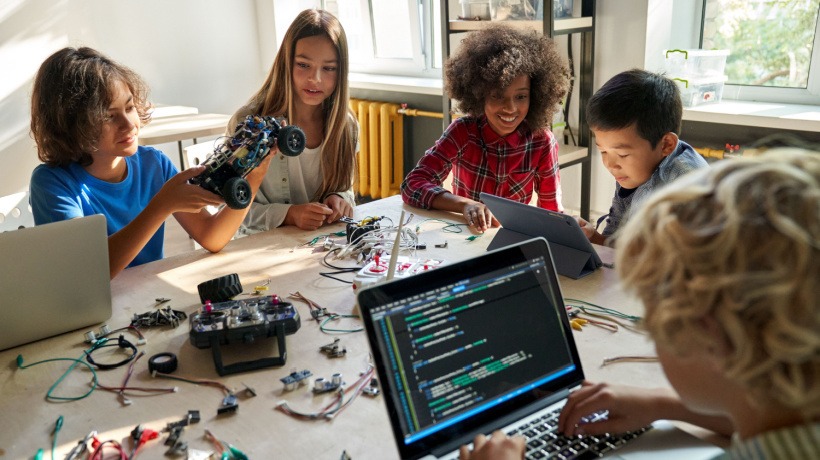Introducing Children To The Wonders Of Artificial Intelligence
Digital assistants, chat boxes, facial recognition, self-driving cars—what we used to consider science fiction and elements of the distant future have now become a part of our everyday lives, transforming our society. Considering the rapid technological advancements we have witnessed in the past decade, one can only wonder how different things will be in five or ten years. Therefore, ushering children into the world of Artificial Intelligence sooner rather than later seems like a natural step to keep this chain of innovation going. In honor of this year's Children's Day, we discuss 5 simple ways to introduce children to AI.
5 Simple Ways To Usher Children Into The World Of Artificial Intelligence
Introducing younger children to AI can ignite their curiosity and kickstart their journey into lifelong learning. It can give them additional tools that enhance their problem-solving skills by teaching them how to expand and channel their creativity to accomplish any goal. Finally, AI in education often promotes collaborative learning, thus helping children become more effective team players. But where do you start? Turning children into AI explorers can be easier than you think. Here are 5 ways to engage them and help them realize the countless applications of Artificial Intelligence in our daily lives.
1. Include Hands-On Activities
We can initiate children's journey into the world of AI with some basic concepts. This would require explaining that AI involves teaching machines how to learn from experiences, much like humans do. However, theory can only get you so far, as children learn better by doing. Thankfully, there are various interactive tools, software, and kits available that are designed to educate children on the basics of coding, robotics, programming, and other AI-related concepts. These resources give children a practical introduction to AI tools while also captivating their attention and igniting their curiosity.
2. Attend Workshops And Camps
As AI rises in popularity, more and more organizations and educational institutions are putting together workshops and camps specifically designed for younger learners. These events, which can either be in-person or online, focus on creating immersive experiences that encourage children to explore various AI concepts. Often, they involve collaboration with other children to create projects, such as building a robot or developing an emotion recognition program. The benefits of such workshops are numerous, as they not only promote collaboration and teamwork but also foster a deeper understanding and appreciation of AI and other STEM-related subjects.
3. Introduce Them To Coding
Coding and programming can seem complicated to many, but they are essential skills for understanding AI. Not to mention that the sooner children are introduced to them, the easier they can begin to understand and master them. Numerous interactive platforms teach kids coding by creating a kid-friendly environment where they can explore and apply its fundamental principles. Children can use these to experiment with the idea of giving machines specific instructions to complete tasks, such as building simple animations. Throughout this process, kids push the boundaries of their imagination and hone their problem-solving skills.
4. Find AI Examples In Everyday Life
When introducing children to AI, it's important to clarify that it's not an abstract concept that doesn't affect them. Help them realize just how many times they interact with AI tools on a daily basis by discussing real-life examples. For example, you can dive into how streaming platforms create personalized recommendations, how autonomous cars operate, or how virtual assistants can answer any question we ask them. Helping children make these connections will increase their interest in AI and the possible ways we could expand its capabilities.
5. Encourage Creativity
The endless possibilities of AI make it a great tool with which children can expand their horizons and learn to think outside the box. So, after discussing the basic concepts and giving children a few initial instructions, it's essential that you let them experiment with AI without limiting them. Art-related AI tools that produce music or poetry are perfect for this purpose. Additionally, make sure to encourage questions and feed their enthusiasm with age-appropriate resources that they can explore in their free time with or without the help of their parents. This way, you can enhance their understanding of AI and turn them into lifelong learners.
Conclusion
There is no denying that Artificial Intelligence is here to stay. And if we want to ensure that it keeps developing in innovative ways, we must introduce children to AI as soon as possible. The earlier younger learners are ushered into the wonderful world of AI, the easier it will be for them to comprehend and learn how to use it to their advantage. Interacting with AI at an early age will equip them with an indistinguishable curiosity for learning and advanced problem-solving skills. As a result, children will be prepared to hold their own and make an impact in the tech-centric future that awaits them. All we have to do is help them take the first step towards AI today.







